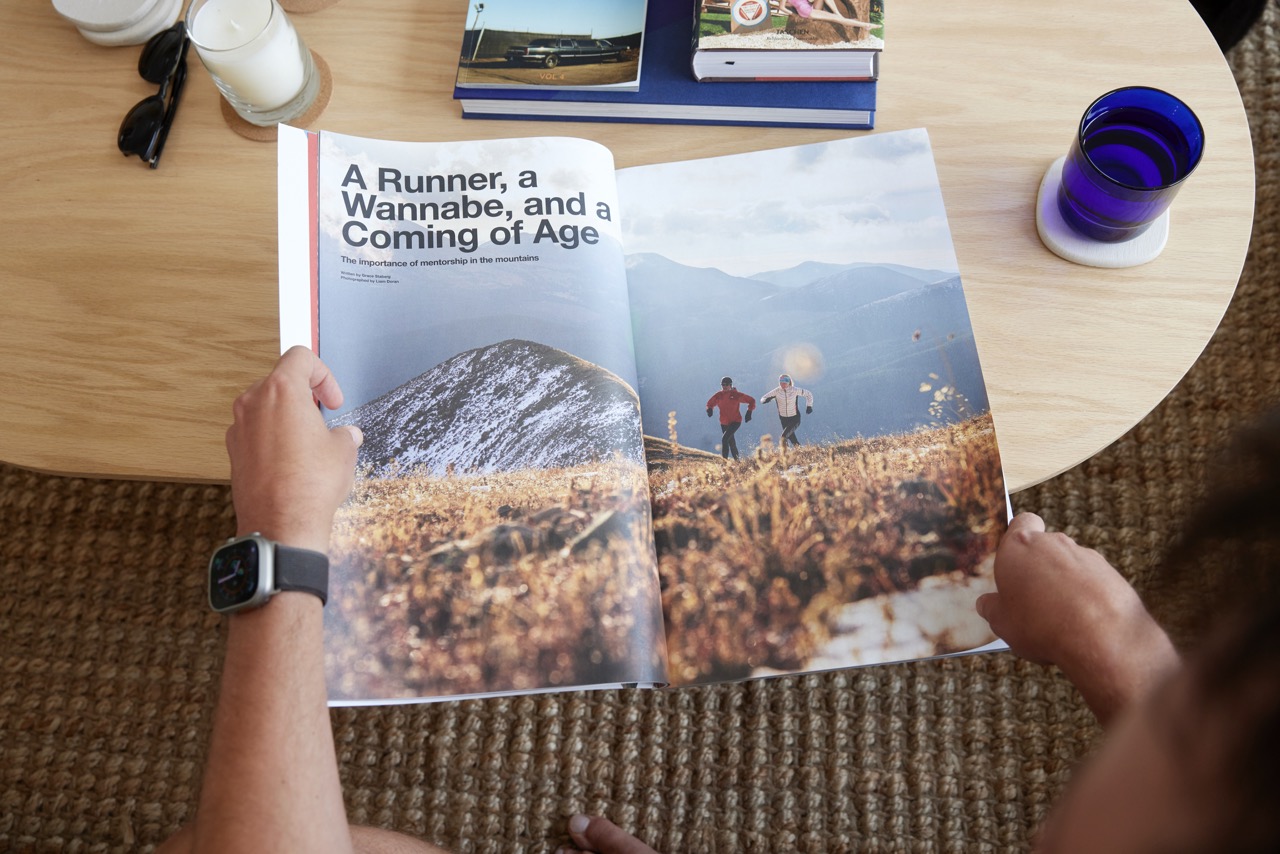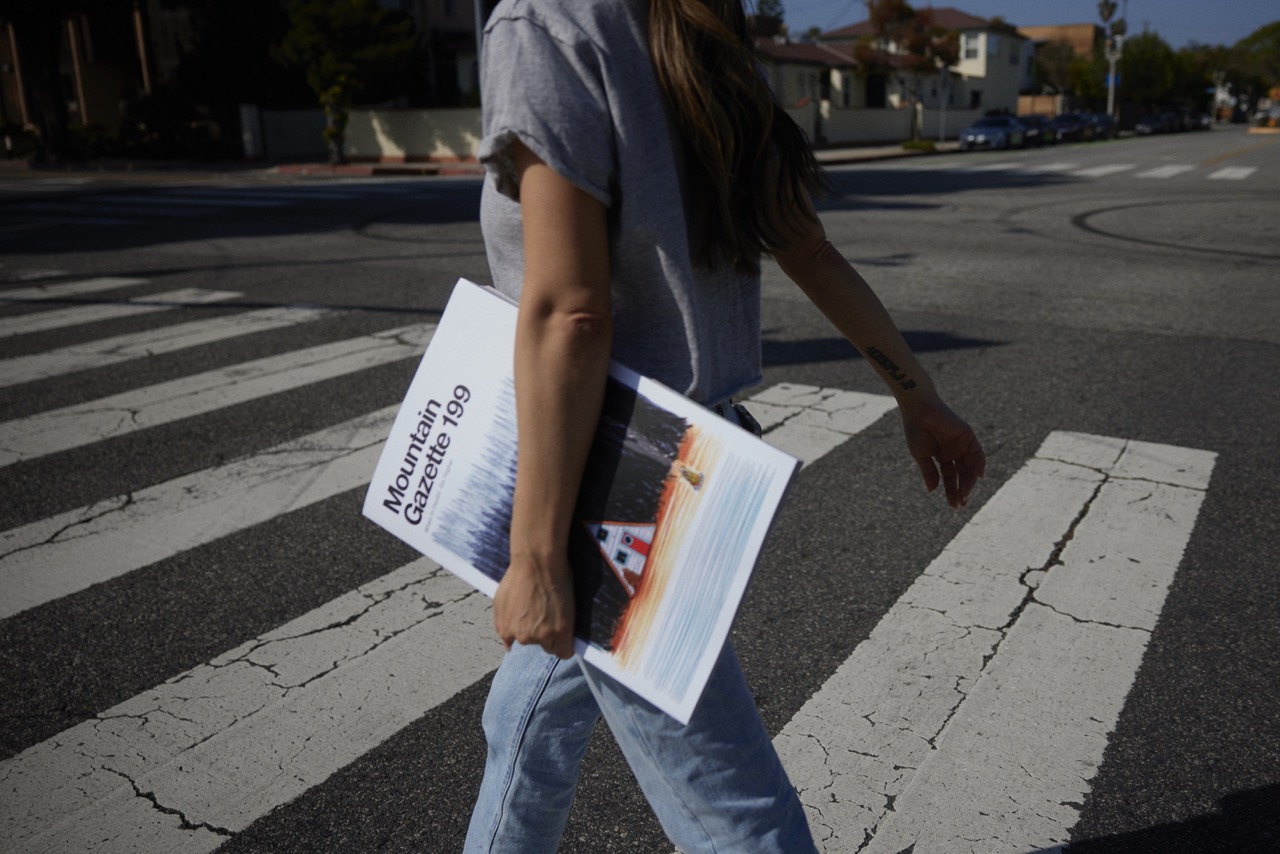
Sometimes, you find that “thing” that resonates. It may not even resonate with you, specifically, but you know it when you see it. It’s something that clearly has an audience it speaks to and is uniquely advocating for.
Mountain Gazette is one of those things. A quick flip through the pages of this outdoor-focus publication tells you a lot about its readership. They like being outside, and they like reading about really cool things. And the secret to its success might just be that simple.
The magazine is about more than being outside and doing fun stuff, though. There are a lot of magazines and websites that scratch that itch. But so few go big on imagery and storytelling — and for our money, none do it better. Mountain Gazette wants to be something different. Better. Bigger (literally). And it’s succeeding.
Recently, I sat down with Mike Rogge, Editor in Chief and owner of Mountain Gazette, to talk about how his cool niche publication gets it so right.
The Manual:
Hey Mike. Thanks for taking the time to chat. How’re things in Lake Tahoe? The news makes it seem like you’re all under feet of snow.
Mike Rogge:
Yeah. So this last winter, we actually made a t-shirt for Mountain Gazette that says, ‘I survived the winter of 2023,’ and we designed it like one of those kitschy amusement park roller coaster things. Like, ‘I survived the big bad wolf’ or whatever, right? I think it’s been a therapeutic buy for people in Tahoe.
The Manual:
Exactly. Merch is always fun to do. So, Mountain Gazette, when did you purchase it?
Mike Rogge:
January of 2020. So the middle of full-pandemic COVID. Do you remember the NBA shutdown in March of 2020? I [purchased the magazine] two months before that. And I got a crash course lesson on how to run a magazine, which is that you need to be stable with how you produce your content. We do two issues a year, large format, and limited advertising, and that doesn’t change. That’s like our foundation, but the rest of it, you gotta move with the times.
But yeah, I bought it in January of 2020. I bought it at a bar at 9:00 in the morning across the street from the Outdoor Retailer Show. In the bill of sale, I was required to buy the previous owner a Coors Banquet beer.
We signed the bill of sale in the Flylow gear booth at Outdoor Retailer because the founder of Flylow officiated my wedding. I bought [Mountain Gazette] like it was a dirt bike. And it kind of was a dirt bike. Really how it existed was the archives were in a storage unit. I inherited so many back issues.
They went to their storage facility and we’re like, ‘Send it to this guy in California.’ And the Archive is brilliant. It’s so cool, and I can just go through it any time. It’s like a mind surf if you’re even a little bit into mountain culture. But then I got old cocktail napkins from a party, too.
I got leftover merch, weird sizes like extra small and XXXL shirts. Nothing anyone I know could fit into. And then we got the URL. We got the Facebook page, which only had like a couple hundred followers. And I inherited a 1,200-person e-mail list that had not been spoken to in nine years.
The Manual:
Wow. So it was dormant. Not even sort of alive at that point.
Mike Rogge:
It went dormant at the end of 2011, early 2012.
The Manual:
So I have to know: It’s a very cool magazine. But it’s been dead for a decade, right? What was that thing where you’re saying to yourself, ‘Yeah, I can resurrect this dead publication’?
Mike Rogge:
I have my own ideas, but I’ve worked with really brilliant editors and publishers in my career. Started off at a local newspaper in Glens Falls, NY. You know, small-town newspapers have been dying at a rapid pace. The Glens Falls Chronicle is still around. They just turned themselves into a digital publication. They’re still printing, but they just turned into a digital pub like a year ago, and they’re killing it, you know. So I learned from Mark Frost, their owner, that you’re never smarter than your readers, Respect your readers. So I was like, okay, I know how to do that. I’ve done that in my whole career.
Then I got to Ski the East, and we had an online community, and what I learned there was to respect your readers, but also be honest with them. If your customer service sucks, say that thing out loud. Don’t try to hide it. Because they’ll call your bluff. And then I got to Powder magazine, and there I learned like, dude, have a soul, have heart. Give people what they want and surprise people, too.
And then after I left Powder, the former publisher of Vice, John Martin, hired me. I don’t know what he saw in me, but he became a mentor. And I got to watch that part of the Vice curve. Obviously, we know where it’s headed now, but it was really fascinating to watch this small Montreal magazine become this show on HBO and watch my friend John, who’s now the CEO of Cream Magazine, just run his business. He kind of taught me the power of the word, what you should and shouldn’t do.
All of those people taught me that if you put all the ingredients together the right way, you can make a real nice spicy meal people wanna buy. And I thought, you know, with Mountain Gazette, my friend Peter Cray had been an editor there, and he said ‘Look, dude, like, this is a beloved title.’
People have asked me why I didn’t just start my own thing. Mountain Gazette has a heritage and a legacy of being the Village Voice of mountain culture, and I thought we could build on that rather than just start something new and tell people what we wanted to be. I think Mountain Gazette was already something I aspired to be. So we grabbed it and my thought was ‘Let’s put some new writers and photographers next to the lineage of Edward Abbey or Hunter S Thompson.’
The Manual:
When I was looking through the magazines, I thought, this feels very like Vice because it’s kind of gritty, right? Was that by design, or is that just instincts kicking in?
Mike Rogge:
We have yet to send an intern to the Westminster Dog Show on acid. So, I would say that’s high praise.
Yeah, you know, we certainly have some superhero-like professional athletes who subscribe and contribute, but they’re people, they’re just people. And I think what we’ve tried to separate is that we don’t have an agenda other than we want our contributors to tell their story from their point of view, and to be vulnerable, and on the gritty side of things, you know.
I wrote about action sports for Vice, and so Vice always had like a — I don’t know if you call lit ike abrasive or confrontational tone, we have that sometimes — but our current issue, we have a 10 or 12-page gallery about rafting. The imagery to me feels amazing because it just feels like I was right there.

The Manual:
Is that why Mountain Gazette is so massive? (The publication is twice the size of a traditional magazine.)
Mike Rogge:
David Reddick, who’s the director of photography at Powder, used to get all these proofs in, and it was awesome. We’d see these giant photo proofs, and then you’d see this thumbnail-size image in the print mag. We just didn’t run it big, but I would see it big. You see someone making a deep pattern [in the snow], and the image is of the moment when they know it’s bottomless, and if they don’t pull up, they might just sink into oblivion. You could see that in someone’s eyeballs. You see it in big format, but when it’s small or on your phone, it doesn’t do the image justice.
The Manual:
So how do you choose what to cover?
Mike Rogge:
Our editorial mission is we cover what happens when you walk out your front door. And we think that’s a more authentic way of covering the outdoor space. We just did an event last week in Boston, and a woman came up and she said, ‘I’ve never considered myself an outdoors person until I started reading Mountain Gazette.’
And we asked her what she meant. She travels the world, she’s got an international sales job, and everywhere she goes, she tries to take one day before she flies home to take a small walk in a city or a hike or spend time in a park. And maybe traditionally, that’s not an outdoorsy person, but I disagree. I think that she had this knowledge base of green space in cities that’s really, really cool and people seek out.
So, when it comes to what we want to cover, I’d say balance is a big thing. When I put together my editorial calendar, I do the activity, then the location, and then, for lack of a better phrase, the vibe or feeling.
Is it aspirational? Is it inspirational? What’s the tone that you’re getting? And like all well-rounded human beings, I try to have a balance. I think our job is to be highbrow and lowbrow. We wanna inform and entertain, and we never let our entertainment get in the way of informing people, and vice versa. So, I also think of it how I make the magazine that I want to read. That was really good advice that Peter Cray gave me last year.
We got over 6,000 submissions from contributors last year, and we published less than 40 of those stories. I spent a lot of time on chair lifts reading submissions.
The Manual:
Making money is hard for any publisher, but you’re only pushing out a few magazines each year with minimal advertising. Not to be crude, but how the hell are you making money?
Mike Rogge:
It’s kind of the anti-magazine model, I guess, is the way I would put it. I open other publications and it’s like 10 advertisements for every three-page story. I wonder how those magazines are doing financially with that model. According to press releases, not so great.
We are no different than Netflix, or Apple TV Plus, or Apple Music. You’re making money on the subscribership. We’re subscriber-based. And you know, man, we didn’t want advertisers, we want partners.
That’s not just me being clever with semantics. Flylow is one of our partners. Their whole thing is owning your own time. We’re the same way. That’s why we don’t do any digital publishing. We have a blog, and I feel like we update it maybe four or five times a year. So what we did was we respected our audience. We built our audience, and then we went to our ad partners, and we said, look, there is no gear coverage [in the magazine]. So, the only gear that could be in here is yours.
There’s no marketplace that looks cheap in the back like a crappy old Craigslist post or the bulletin board at our local post office. There’s more interesting stuff. And then what’s great is that our ad partners stick with us. We have a six- or seven-brand waiting list right now to get into Mountain Gazette, in part because it’s scarce, it’s twice a year. And I also think it’s a better value.
We thought there was a market to make a close-to-perfect print product which is large format long stories. My writers will tell you it is both intimidating and welcoming.
The Manual:
And readers love it, I’m sure.
Mike Rogge:
Most of our readers collect the magazines and keep them forever.
I’d say that the secret sauce is we give a shit about people. You know, we’ve had subscribers that have literally had their dogs eat a copy of their magazine, and we feel terrible, and we send them a new issue. We are not at all responsible for that dog doing that, but we’re like, ‘Hey, we got you.’
The Manual:
Do you tell readers that if their dog ate their magazine, they have to send you pics?
Mike Rogge:
[laughs] Yeah, that’s only fair. It’s not even for proof. We believe them. It’s just that we need it for the wall in the office.
One guy made the comment like, ‘Wow, this is a really big piece of kindling.’ And I was like, ‘I dare you to burn this thing.’ Dude, I was like, ‘I dare you to. I dare you to!’ And I want to see photos of it and a video in slo-mo. And I hope you pour gasoline on it, and it explodes. He’s like, ‘I just couldn’t bring myself to do it.’
You can’t just go pick another one up, right?
The Manual:
Seems like you’re on the right path, but what’s your biggest challenge?
Mike Rogge:
Our biggest challenge is that not very many people know about us. We have just over 6,000 subscribers, I have no problem saying that. And we’re adding between 200 and 300 subscribers a month. In April, we added 600. And we’re only losing about 120 subscribers a year.
The Manual:
That’s really good. Impressive.
Mike Rogge:
Yeah, and we’re profitable. I have no investors. No one on my team hates me — or at least they haven’t told me that. [laughs] I think pretty much everyone that works for us has gotten either put on a retainer or gotten a raise. And that’s by design because I’ll tell you that my marketing guy rides his bike and skis more than any marketing director I know. Our art director fly fishes and plays music a ton.
Our community manager, she handles our social media. Honestly, if you interact with our Instagram or Facebook page, you’re talking to Amy. Amy has flower arrangements on the side and surfs around the world with her husband. Like, it’s a lifestyle.
I don’t work 40 hours a week for Mountain Gazette. None of us do, typically, unless it’s closer to publication time. You know, I got to ski 100 days this year and run a revenue-positive business, and I have no investors, and everything’s okay. And what do we do when we grow revenue? Well, so far, every single issue, we put more money into paying contributors, and that’s not necessarily more money per word or per photo, but it’s per project.
We let two of our writers work for six months on a mutton-busting piece. Why? Because we’ve heard from the families [in the article] that that’s the definitive piece on mutton-busting, and we think that’s great.
And I think that is just so worthwhile because it makes our products better. It means our subscribers are going to stay with us longer. We’re not just doing more stuff. You know what I mean?
We’re not expanding our offerings or anything like that. Like, we’re gonna make two issues a year, and we’re gonna make sure that they keep getting better and better and better. And I think it sounds so simple, but it really is that simple if you give a shit about people.
The Manual:
So is this it? Is Mountain Gazette your forever thing?
Mike Rogge:
I recently wrote this feature about the band Goose. We’ve been getting into music a little bit for the magazine; in issue 198, there’s a piece about Goose. But it’s also about how their music helped me through a hard time when my wife and I were trying to decide if we’re gonna have another kid. And a reader came up to me, and he’s like, ‘Dude, like, I’m not the shred-bro. I’ve never watched ski or snowboard flicks. I like being outside. Also, my wife and I are trying to have a kid. So I got this outdoor magazine thinking, I’ll try it.’
And he read that story and he told me it made him feel like he wasn’t alone. And, you know, I’m kind of getting emotional, but that’s one of the most validating feelings I’ve ever had.
I’ve had films I directed in the Banff Mountain Film Festival, I’ve published a book, and all those things felt really good, accomplishment-wise. But hearing that dude tell me that a story that we wrote made him feel less alone like that?
I’ll do this for the rest of my life. I’ll never sell it. And we’ll just do this forever because why not do more of that in the world, you know?



